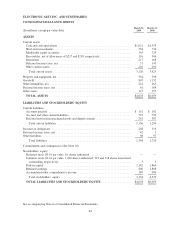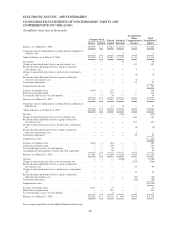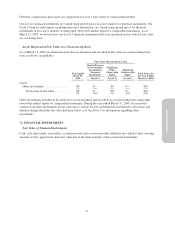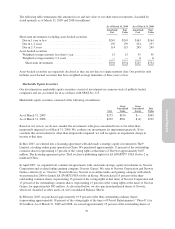Electronic Arts 2009 Annual Report Download - page 151
Download and view the complete annual report
Please find page 151 of the 2009 Electronic Arts annual report below. You can navigate through the pages in the report by either clicking on the pages listed below, or by using the keyword search tool below to find specific information within the annual report.
Annual Report
We completed the first step of the goodwill impairment testing in the third quarter of fiscal year 2009 and
determined that the fair value of our EA Mobile™ reporting unit fell below the carrying value of that reporting
unit. As a result, we also conducted the second step in the third quarter of fiscal year 2009 in accordance with
SFAS No. 142 and determined that the EA Mobile reporting unit’s goodwill was impaired. During the fiscal year
ended March 31, 2009, we recorded a goodwill impairment charge of $368 million related to our EA Mobile
reporting unit. We did not recognize any goodwill impairment charges in fiscal years 2008 and 2007.
Taxes Collected from Customers and Remitted to Governmental Authorities
Taxes assessed by a government authority that are both imposed on and concurrent with specific revenue
transactions between us and our customers are presented on a net basis in our Consolidated Statements of
Operations.
Concentration of Credit Risk
We extend credit to various companies in the retail and mass merchandising industries. Collection of trade
receivables may be affected by changes in economic or other industry conditions and may, accordingly, impact
our overall credit risk. Although we generally do not require collateral, we perform ongoing credit evaluations of
our customers and maintain reserves for potential credit losses. Invoices are aged based on contractual terms with
our customers. The provision for doubtful accounts is recorded as a charge to operating expense when a potential
loss is identified. Losses are written off against the allowance when determined to be uncollectible.
Short-term investments are placed with high quality financial institutions or in short-duration, investment-grade
securities. We limit the amount of credit exposure in any one financial institution or type of investment
instrument.
Revenue Recognition
We evaluate the recognition of revenue based on the criteria set forth in SOP 97-2, Software Revenue
Recognition, as amended by SOP 98-9, Modification of SOP 97-2, Software Revenue Recognition, With Respect
to Certain Transactions and Staff Accounting Bulletin (“SAB”) No. 101, Revenue Recognition in Financial
Statements, as revised by SAB No. 104, Revenue Recognition. We evaluate and recognize revenue when all four
of the following criteria are met:
•Evidence of an arrangement. Evidence of an agreement with the customer that reflects the terms and
conditions to deliver products that must be present in order to recognize revenue.
•Delivery. Delivery is considered to occur when a product is shipped and the risk of loss and rewards of
ownership have been transferred to the customer. For online game services, delivery is considered to
occur as the service is provided. For digital downloads that do not have an online service component,
delivery is considered to occur generally when the download is made available.
•Fixed or determinable fee. If a portion of the arrangement fee is not fixed or determinable, we recognize
revenue as the amount becomes fixed or determinable.
•Collection is deemed probable. We conduct a credit review of each customer involved in a significant
transaction to determine the creditworthiness of the customer. Collection is deemed probable if we expect
the customer to be able to pay amounts under the arrangement as those amounts become due. If we
determine that collection is not probable, we recognize revenue when collection becomes probable
(generally upon cash collection).
Determining whether and when some of these criteria have been satisfied often involves assumptions and
management judgments that can have a significant impact on the timing and amount of revenue we report in each
period. For example, for multiple element arrangements, we must make assumptions and judgments in order to
(1) determine whether and when each element has been delivered, (2) determine whether undelivered products or
services are essential to the functionality of the delivered products and services, (3) determine whether vendor-
71
























